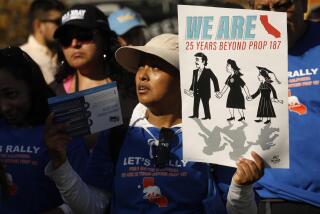Who’ll be the 300-millionth American?
- Share via
NEARLY 30 years ago, President Lyndon B. Johnson stood before the U.S. Census Bureau’s Population Clock to proclaim the arrival of the 200-millionth American.
But don’t expect President Bush to do the same when the 300-millionth American is anointed within a week or so.
This time around, because of the milestone’s connection with the politically charged issue of immigration, and because of the backlash immigrants have generated in much of the country, the president most likely will remain quiet.
Because the truth is, it is immigration that is driving the growth of the U.S. population. In fact, odds are that the 300-millionth American will be the child of immigrants or an immigrant himself -- as likely as not born or residing in Los Angeles. Right now, about half of U.S. population growth in any given year or month is attributable (through migration or natural increase) to Latinos, the vast majority of whom are either first- or second-generation Americans. To celebrate this fact publicly just a few weeks before the midterm elections would be tantamount to rolling the political dice.
The volatility of this issue has much to do with the culture clash that this 300-millionth American symbolizes: He or she is arriving, after all, in a profoundly different mainstream America than 30 years ago.
At the heart of of this mainstream are the baby boomers, who now comprise most adults over age 40. This much-ballyhooed generation came to embody the image of middle America during the second half of the last century. Conceived during the prosperous post-World War II period, they brought a rebellious, progressive sensibility to the country in the 1960s and ‘70s and beyond. With the help of the programs of the Great Society, they became the most well-schooled generation to date and the epitome of America’s largely white suburban middle class with which most of today’s adults now identify.
Yet, the boomers also came of age at a moment when the U.S. was becoming more insular than it had been before; they, in fact, had less exposure to immigrants and foreign wars than their parents. From 1946 to 1964, the years of the boom, the immigrant share of the U.S. population shrunk to an all-time low (under 5%), and those who did arrive were largely whites from Europe.
Despite their interest in righting domestic wrongs, such as racial discrimination, and bursting glass ceilings, boomers did not have much interaction with people from other countries.
Perhaps it should come as no surprise then that the once liberal baby boomers -- who now constitute the core of middle-aged middle America -- should be resistant to the country’s new younger generation, increasingly made up of first- and second-generation Latin Americans and Asians.
This is especially the case as these newcomers spill out to a heartland which, until recently, was strewn with modern-day “Leave It to Beaver” communities -- a dispersal that has spawned about 500 largely anti-immigrant bills introduced in the first half of this year, according to the National Conference of State Legislatures.
What used to be thought of as white flight on the part of the previous generation, which flocked to the suburbs during the 1950s and ‘60s, is now taking the form of “white fright.” Indeed, a Pew Research Center survey in March shows that more than half of the population over 50 believes that immigrants are a burden because they take housing, jobs and healthcare.
Yet, there is actually little need to worry about immigration. It adds a needed youthful element to a population that would become stagnant if it had to rely on the far-below-replacement fertility of the nation’s aging native-born whites. Their infusion into the workforce will be especially useful to retiring boomers who wish to be supported in their golden years.
The low immigration years, through which most of today’s adult population grew up, were atypical in our history. The “pull yourself up by the bootstrap” attitudes of the early 20th century foreign-stock generations, who survived the Depression and World War II, created the circumstances that made way for the baby boomers.
THE SAME KIND of can-do attitudes are evident among early 21st century immigrants and their children, who show a willingness to work hard, learn English, move to the suburbs and achieve the American dream.
Today’s immigration debate is both emotionally and politically charged, but a more rational discussion is possible once the dust settles after the November elections. Such a discussion should move beyond the immediate illegal immigration rancor and focus on how best to provide our newcomers and their children a pathway to the middle class -- the same path we and our parents were handed.
Meanwhile, let’s celebrate the arrival of the 300-millionth American, be he from across the border or born to a Latino mother here in Southern California. He may not be a boomer, but he is our future.
More to Read
Get the L.A. Times Politics newsletter
Deeply reported insights into legislation, politics and policy from Sacramento, Washington and beyond. In your inbox three times per week.
You may occasionally receive promotional content from the Los Angeles Times.










